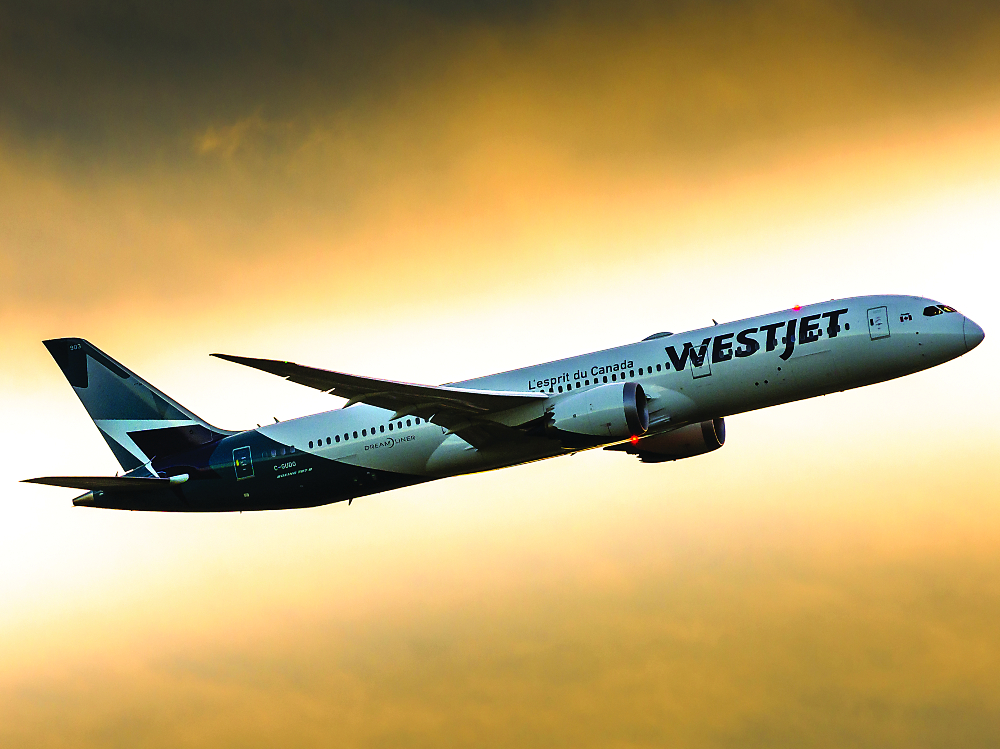Estimated reading time 5 minutes, seconds.
When Onex Corp. completed its $3.5-billion acquisition of WestJet Airlines Ltd. in December, it marked a major milestone in the carrier’s history.

The Toronto-based private equity firm, led by billionaire Gerry Schwartz, paid $31 a share for Calgary-based WestJet. Including the assumption of WestJet’s $1.5-billion in debt, the enterprise value of the transaction totals $5 billion.
WestJet chief executive officer Ed Sims, who leads the airline with 14,000 employees, said he’s looking forward to collaborating with Onex.
“These are deeply intellectual people who are going to add an awful lot of structuring and financial horsepower to the capability we already have in the organization,” said Sims in an interview with Skies. “It’s a formidable combination to bring these two organizations together.”
Sims, who was born in Wales, has an eclectic background.
He graduated with a degree in English from Oxford University in 1985 and has worked in the tourism and aviation sectors for more than 30 years, with experience in Britain, Europe, Australia and New Zealand before arriving in Canada.
Sims left air navigation service provider Airways New Zealand to join WestJet in May 2017 as commercial vice-president. He has been WestJet’s CEO since March 2018, taking over from Gregg Saretsky, who had served in the top job for almost eight years.
WestJet has steadily expanded from humble beginnings, launching with three used Boeing 737-200s in February 1996, and staffed by employees called WestJetters.
Today, WestJet not only has its mainline operations, but also oversees regional flights through Encore and Link, as well as discount carrier Swoop.
The 737-200s in a single-class cabin are long retired, but newer versions of the single-aisle 737 aircraft continue to serve as the airline’s workhorses. After concentrating on Canada for its first eight years, WestJet branched out into the United States in 2004.
Over the years, Canada’s second-largest airline added turboprops to its regional fleet, notably the Bombardier Q400 (now known as the De Havilland Dash 8-400).
The addition of Boeing’s twin-aisle 787 Dreamliner in 2019 meant WestJet would make plans to start competing aggressively overseas, including on routes where Air Canada and foreign rivals have been flying with varying degrees of success.
WestJet’s expansion has been bolstered by its rewards program and credit card affiliation that targets frequent fliers willing to pay for premium class seating.
“The network that we fly, if I think of the 42 cities that we now serve in Canada and 27 cities we now fly in the U.S., the network itself is more business and more premium-oriented,” said Sims.
WestJet’s fleet includes Boeing next-generation (NG) aircraft such as the 737-700 and 737-800.
“We now carry what I would call a premium economy rather than a business-style service on board all of our NGs, as well as the new Maxes.”
The grounding of Boeing’s 737 Max jet program in March 2019 created significant scheduling complexities for carriers worldwide, and WestJet was no exception. WestJet had been operating 13 Boeing Max 8 planes before the grounding, which followed two deadly crashes within a five-month span.
“Lesson number one for us has been just how challenging it is to get the world’s regulators on the same page,” said Sims. “This is not the first time an aircraft type has been grounded. But it’s the first time an aircraft type has been grounded in the era of social media.”

On Jan. 21, WestJet announced it had removed the Max from its flight schedule through to June 24, 2020. This adjustment was made following a statement by Boeing in which the OEM revised its service re-entry estimate to mid-2020. WestJet said it has managed to complete more than 98 per cent of its planned departures even while its 13 Max aircraft have remained parked.
For his part, Sims is focused on the path ahead after WestJet faced an array of labour issues amid unionization drives over the past couple of years.
“I’ve had a lot of time in heavily unionized environments in other airlines and I see a fantastic opportunity to move away from discussing issues that divide us to actually negotiating on the interests that unite,” said Sims. “The potential for unions to attract their members and the potential for WestJetters to feel 100 per cent comfortable, and no sense of misalignment of being part of a union and being a loyal WestJetter – that has taken us some time.”
The Canadian Transportation Agency gave regulatory approval to Onex’s WestJet purchase in December, reminding the private equity firm to stay onside with requirements that WestJet and Swoop continue to adhere to Canadian ownership rules. Non-Canadians are allowed to own up to 49 per cent of the voting interests in a Canadian carrier, and a single foreign investor is allowed to own a maximum of 25 per cent.
Chris Murray, an analyst with AltaCorp Capital Inc., said the CTA’s insistence on regulatory compliance, including the composition of Onex’s board of directors, doesn’t appear onerous.
Sims said WestJet will be competing hard in 2020, hoping to increase its market share among air passengers. Its domestic slice of the pie has been around 34 per cent recently, while nearly 20 per cent on transborder into the United States and less than 10 per cent on transatlantic.
“We’re now carrying one in three Canadians on our domestic services, and we carry a significantly lower share of Canadians on transborder services and lower again on transatlantic,” said Sims.
“Our vision under Onex is that we can match our transborder and our transatlantic share, to be lifted to those levels of domestic,” he said. “I think that’s a huge opportunity.”

Westjet…the little airline that started as a Modest , Decent Airline …and then grew into a Big Bully on the Block with a Love child SWOOP …should be called POOP..
How does Ed Simms even have this job?? Clearly his resumé would indicate he doesn’t have the experience. Also where does he come up with this stuff?? Increase market share?? How?? Domestically in Canada and transboarder a very tired fleet of NG’s in desperate need of refurbishment competing against Air Canada Dreamliners, 777, and Airbus a330 on domestic routes like Toronto to Vancouver, and now the new a220 on thinner routes. Westjets domestic market share is actually shrinking. The hard product is apples vs rotten oranges, westjets product is in a word terrible. Not to mention an ever increasingly disgruntled workforce, I would imagine the flight attendants will hold a strike vote in 2020. As for long haul international routes how do you even begin to gain market share or compete with only 4 aircraft (787) ?? Onex had better take the helm and turn that ship around and quick because to me WestJet just looks like another Canadian aviation failure not far on the horizon.